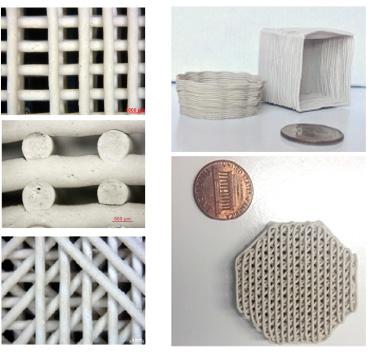
1 minute read
Materiali avanzati
Materiali avanzati Advanced Materials
DII research group Advanced Ceramics and Glasses
Advertisement
01
Paolo Colombo paolo.colombo@unipd.it +39 049 8275825
Assisted by Giorgia Franchin, PhD student Hamada Elsayed, PhD student, Paolo Scanferla, research assistant Luca Zeffiro, undergraduate student
Main research topics • Polymer-Derived-Ceramic components from preceramic polymers • Ceramic components from geopolymers • Advanced ceramic and glass foams by direct foaming • Additive manufacturing of ceramics (Direct Ink writing (DIW), Powder-bed (3DP), Stereolithography (SLS)
Direct Ink Writing of Geopolymers
Geopolymers are based on an inorganic 3D network of alumino-silicate units usually synthesized through the reaction of alumino-silicate powders (e.g. metakalolin) in presence of a silicate alkaline solution. e rheological characteristics of the reactive mixtures and the fact that these systems can consolidate at low or even room temperature, together with their intrinsic micro- and meso-porosity and good mechanical properties, are the reason why they are considered for a wide range of applications, such as construction materials, thermal insulation, filters, adsorbers and so on. Our group has been exploring innovative fabrication processes for geopolymer components, focusing on foaming or additive manufacturing technologies. We used, for the first time, mixtures based on an alkaline-geopolymer for 3D printing of components of complex shape which can be used at room or even at high temperature, as they can easily withstand heating up to at least 1200°C. In particular, we investigated and controlled the rheological properties of geopolymer material, in order to develop inks suitable for generating structures with large overhangs and spanning features, to be employed, for instance, for filtration applications. Different water contents and different types and amounts of additives were used to control and enhance the Bingham pseudo-plastic behavior of the inks. Such optimization resulted in the ability to fabricate components with large overhangs and spanning features, including highly porous 3D lattices.
Scaffolds with a total porosity of ~45 vol% possessed a compression strength higher than 10 MPa, which decreased to ~2 MPa when the porosity increased to ~65 vol%.





